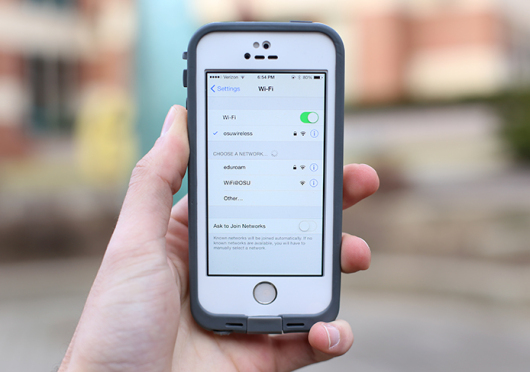
Of the more than 9,000 access points available for OSU’s wireless network, a reported 1,925 are scheduled to be upgraded by the end of this semester. Photo illustration by Mark Batke / Photo editor
Waiting for endless video buffering and slow file downloads could be a thing of the past after Ohio State’s Office of the Chief Information Officer upgrades more than 1,900 wireless network access points on campus.
OSU’s wireless network currently has more than 9,000 access points, according to an OCIO press release. Of those, 1,925 are scheduled to be upgraded by the end of this semester, said Katharine Keune, spokeswoman for the OCIO.
An access point is a piece of technological infrastructure that allows wireless devices like laptops, tablets and phones to connect to a wireless network via Wi-Fi, said Ryan Holland, senior network engineer for the OCIO. The access points are usually attached to the ceiling or walls of a room, he said.
Upgrading each access point costs approximately $550, Keune said. She added that the money for the project came from the “current budget and funding reserved for this project within the OCIO.”
It takes approximately 10 minutes to upgrade an access point, Holland said. However, he added, because there are multiple access points in many buildings, Wi-Fi users will most likely be routed to a different access point while the others are being upgraded.
“There are multiple access points and they will keep servicing the area,” he said. “So if we pull one down, that one will no longer be functioning, but there are remaining ones in place.”
OSU began installing access points as a part of its University Wireless Project, which took place in 2006, Holland said.
The project started with approximately 297 wireless hotspots in more than 108 campus locations, according to an OCIO blog post from January 2006. Now, however, Holland said Wi-Fi use has increased, which requires many of the older access points to be upgraded.
“Wi-Fi is no longer a service, it is literally a requirement,” he said. “It is no longer just people having laptops in class, they all have their phone in their pocket and half of them are bringing their tablets. So as people bring all of these devices, they are all trying to use the Wi-Fi simultaneously.”
Holland said the university has recorded a maximum of 48,000 devices being simultaneously used on the wireless network at one given time, but noted that more devices can be logged in to the network throughout the day.
“We might see 100,000 unique devices throughout the day,” he said.
The OCIO plans to finish a campus-wide installation of upgraded access points by the end of the semester, and has already upgraded approximately 1,800 access points, Holland said. He added that the OCIO expects most of the project to be complete by the beginning of April.
“We are hoping to get 98 percent of it all done in the next two weeks,” Holland said.
Individual departments and colleges are generally responsible for upgrading the access points, Holland said. The OCIO is working with departments and colleges that will be directly affected by the remaining upgrades, he added.
Kyle Hoyer, a fourth-year in health sciences, said he has been generally pleased with the Wi-Fi at OSU.
“At first, when I went to Miami (University) freshman year, the Wi-Fi here was 10 times better,” he said. “I feel like it has definitely improved over the last few years.”
Although he has seen improvements, Hoyer said he still notices issues with Wi-Fi connectivity on certain parts of campus and with specific devices like his cellphone.
“OSUwireless, especially on the medical campus, is always hard (to connect to),” he said. “I know at the beginning, when I transferred here, I had to go to the Buckeye Bar at Thompson because for some reason I could not stay connected (to the Wi-Fi), so I had to keep reconnecting.”
Hoyer said he thinks the upgrades will help the university’s wireless network keep up with changing technology.
“I think it is really smart that they are doing (the upgrades) because of all of the technological innovations. It is going to be hard to keep up because of all of the technology,” he said. “I think it is a really good idea (to update the access points).”
Holland said he hopes that the upgrades to access points will enhance Wi-Fi users’ digital experience, for both recreational and educational purposes.
“We will all have a better experience because it won’t take as long to load videos, (and) it won’t take as long to upload files to Carmen,” he said. “By adding more bandwidth, (Wi-Fi users) are going to be able to have more devices connected and (they) are going to be having a better experience while on the wireless network because (they) will have faster speed.”


